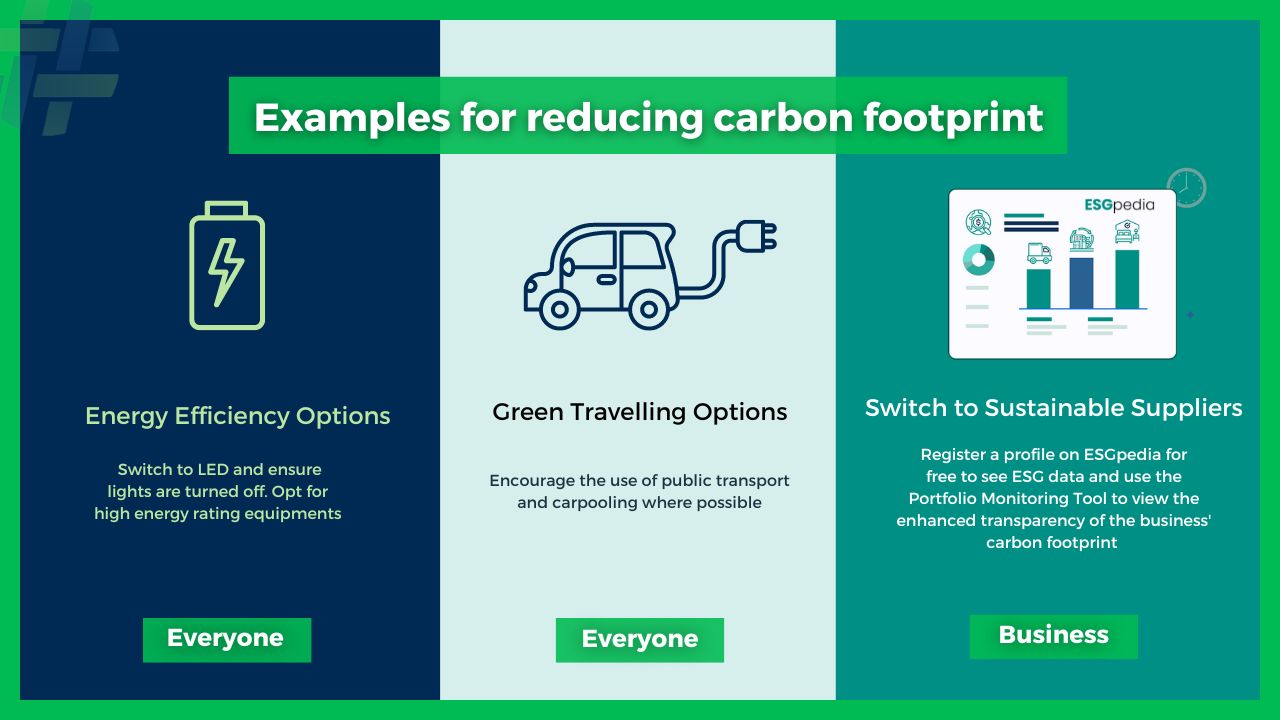Climate change has often been touted as the greatest challenge of our time. Yet, countries are still severely off-track in their progress towards sustainability goals. Countries in the Organisation for Economic Cooperation and Development, better known as OECD, are also falling short on their progress towards achieving the Sustainable Development Goals (SDG), with most only reaching a quarter of their targets.
Businesses play a key role in the race to net zero. Yet, a multitude of taxonomies, standards and a lack of appropriate tools leave many unsure of where to begin. So, where should businesses start?
It all begins with understanding and calculating their own corporate carbon footprint. While significant resources and effort might be required for businesses to measure their carbon emissions, calculating their carbon footprint allows businesses to understand their emissions and develop an effective decarbonisation strategy.
Taking this step also benefits businesses in other ways, such as being able to:
- Build business resilience through adhering to current laws and preparing for future regulations
- Fulfil increasing demands from clients and investors
- Cut business running costs and maintain competitiveness
- Enhance their credibility with the public
- Combat climate change
This article will go over how businesses can measure their corporate carbon footprint, and the steps they can take to craft an effective decarbonisation strategy.
What is a Corporate Carbon Footprint?
What are Scope 1, 2, 3 Carbon Emissions?

Scope 1 Carbon Emissions: Direct emissions from sources owned and controlled by the company
- These emissions are generated by the company as a direct outcome of its activities
- Examples include gas for heating, fuel used onsite, and fuel for company vehicles
- Emissions sources can also include industrial air conditioning, manufacturing carbon emissions, and refrigerant leakage
Scope 2 Carbon Emissions: Indirect emissions from upstream activities
- Companies are responsible for GHG released by the energy producer
- These include emissions from a company’s purchase of energy like electricity, steam, and heat
- Higher energy consumption by businesses results in increased energy production by the producer, resulting in higher indirect emissions
Scope 3 Carbon Emissions: Indirect emissions from sources not owned by company
- These encompass emissions that are not directly generated by the company or from the assets it owns or manages, but from activities that it is indirectly accountable for, throughout its entire value chain
- Some examples include buying and using products and services, distributing them, managing their waste, traveling for business purposes, and various other activities related to their products and services, etc.
Calculating Your Corporate Carbon Footprint
To better understand the impact of their activities on the environment, businesses must first calculate their corporate carbon footprint. Global standards for GHG accounting include the GHG Protocol, ISO 14064, the Partnership for Carbon Accounting Financials (PCAF).
Challenges in carbon footprint calculation
- Data collection: Obtaining the required information on a firm’s carbon footprint, including energy usage, transportation, waste management, and other contributing factors, can be a tedious, labor-intensive, and challenging task for companies
- Data accuracy: Even if data is available, companies could be affected by incomplete or inaccurate data, complicating the calculation process
- Complexity of calculations: Calculating a company’s carbon footprint involves intricate calculations and may require specialised knowledge and expertise, which can be a daunting task for some businesses
- Cost: Companies may need to invest in equipment and manhours to assist in gathering the necessary emissions data to facilitate the calculation
- Lack of internal resources: Certain businesses may face difficulty in conducting a carbon footprint calculation due to their lack of internal resources and expertise in the field of sustainability
- Limited understanding of the benefits: It can be challenging for some businesses to allocate limited resources to the task of calculating their carbon footprint, especially if they do not fully understand the benefits of doing so or do not consider it a priority
Solutions for Corporates to Calculate their Carbon Footprint and Emissions
Providing a Central ESG Data Registry via ESGpedia

To address the challenges of data collection and data accuracy, STACS has partnered with the Monetary Authority of Singapore’s (MAS) Project Greenprint, to develop and operate ESGpedia as the central Environmental, Social, and Governance (ESG) registry for financial institutions and corporates. ESG data, including emissions data and globally verified certifications across multiple sectors, are aggregated on the common registry, alongside actionable digital tools to provide companies a one-stop platform for their various ESG and decarbonisation needs.
STACS partners with carbon measurement technology and carbon management accounting providers to provide a one-stop solution to corporates, where their emissions can be effectively quantified, either on a product- or company-level, to help them better understand their emissions profile. This information is piped to ESGpedia to help corporates create their very own ESG profiles for access by their key stakeholders – investors, financiers, and clients.
Connect with us to learn more if you are a corporate looking to decarbonise and enhance your ESG profile or if you are a keen solution partner.

For businesses who often prefer to start their net zero journey simply and quickly like Small and Medium Enterprises (SMEs), a new alternative has been emerging – SME Sustainability Disclosure Questionnaires.

In this regard, STACS will be launching a globally-recognised digital corporate questionnaire tool in May with an intergovernmental organization. To help SMEs go one step further in qualifying for green financing by banks, STACS is also partnered with global assurance bodies like TÜV SÜD PSB, Bureau Veritas, and British Standards Institution (BSI) to provide assurance on such self-disclosure reports to streamline the sustainability financing process.
Ways to Reduce Carbon Emissions for Businesses and Consumers

Once companies have assessed their corporate carbon footprint and determined the sources of emissions they wish to target with a carbon footprint calculator, they can take the next step in achieving their net zero goals by exploring options to reduce their emissions. Listed below are 3 ways companies can reduce their emissions. To evidence their efforts and progress, it is also critical for companies to track their decarbonisation journey, in terms of carbon emissions data, on a digital platform.
- Increase Energy Efficiency
Energy usage relates directly to a company’s Scope 2 emissions. Businesses can reduce their energy consumption by switching to LED lighting and turning off lights when leaving the office or use natural daylight as much as possible. Using appliances with high energy ratings can help reduce energy usage. Additionally, enabling energy-saving and battery-saving modes on all work devices, including PCs and mobile devices, can help save energy and reduce carbon emissions. By adopting these practices, businesses can make a significant impact on their energy consumption and reduce their emissions. - Promote Greener Travelling Options
One of the most effective ways businesses can reduce their carbon emissions is to encourage their employees to use public transport, since motorised transportation accounts for a significant amount of global GHG emissions.For meetings and business trips that must be conducted in-person, companies could also encourage their employees to carpool to the meeting venue, or suggest that staff use public transport to travel, especially if these are single-passenger journeys.
- Switch to Sustainable Suppliers
Scope 3 emissions take into account the GHG emissions produced by a business’ suppliers. Hence, it is imperative that businesses partner with suppliers who equally value sustainability, and actively seek to decarbonise their business operations. To do this, businesses require a robust supplier sustainability monitoring platform, such as ESGpedia. STACS’s ESG data platform provides holistic ESG data and a Portfolio Monitoring Tool for monitoring the sustainability performance of suppliers in a business’ end-to-end supply chain, allowing them to select suppliers according to their emissions data. These capabilities enhance the transparency of the business’ carbon footprint for its stakeholders, potentially unlocking greater financing through visibility to financiers.
Request a demo to learn how ESGpedia helps companies to track their emissions data and monitor their suppliers’ sustainability on a common platform.
Offsetting Residual Emissions with High-Quality Carbon Credits
On the journey to net-zero, carbon credits are a necessary component in business’ decarbonization strategies, allowing businesses to offset residual emissions they are unable to eliminate. While a plethora of carbon offset projects, not all carbon credits are created equal. To truly enact climate impact, carbon credits used by businesses to offset their emissions must be ‘high-quality’, defined in a McKinsey article as meeting the 5 tenets of being real and measurable, permanent, additional, independently verified, and unique and traceable.
Read more about High-Quality Carbon Credits for Sustainability here.

STACS’s ESGpedia supports businesses in offsetting their emissions by providing aggregated data on carbon offset projects across major carbon credits registries, like Verra and Gold Standard. In addition to these global registries, STACS also partners with country carbon registries, such as Thailand’s T-VER. Through ESGpedia, businesses attain a one-stop view of verified, high-quality carbon credits project data across various geographies. When a business establishes a profile on the ESG data platform, it would also be able to provide its clients, partners, suppliers, and other stakeholders with a comprehensive overview of its offset activities.
Fractionalised Carbon Credits enable Consumers to Offset Emissions

Today, fractionalised carbon credits also allow businesses to rope consumers in to play a part in global decarbonisation efforts, by offering them the chance to offset emissions generated by their purchases and activities. Previously, consumers were unlikely to purchase a full carbon credit, equivalent to offsetting one metric ton of emissions, since their purchases and activities rarely generated that amount of emissions. However, advancements in technology have enabled carbon credits to be ‘broken down’ into smaller denominations, making carbon offsetting accessible to the average consumer. While currently mostly applicable to e-commerce, this technology has the potential to be used in other industries, such as .
Learn more about Restorify, our fractionalised carbon offsetting solution in partnership with Razer Inc, with end-to-end traceability on ESGpedia.
Take the First Step Today to Address Your Carbon Footprint – Calculate, Understand, Reduce
The crucial first step in a company’s decarbonization journey is to calculate its corporate carbon footprint. While gathering the necessary data can be challenging, understanding the factors that contribute to its carbon footprint is essential to develop an effective decarbonisation strategy. Taking this first step unlocks the door to reducing and offsetting emissions.
While some companies may lack the resources or expertise, solutions are becoming increasingly simplified, allowing businesses of all sizes to partake in the global movement towards net zero and the prospect of a more sustainable future.
Start your net zero journey on ESGpedia to understand your current sustainability standing, and gain access to holistic data and digital tools to better manage your corporate carbon footprint.
PRESS CONTACTS
If you are a journalist with media queries, contact us.




